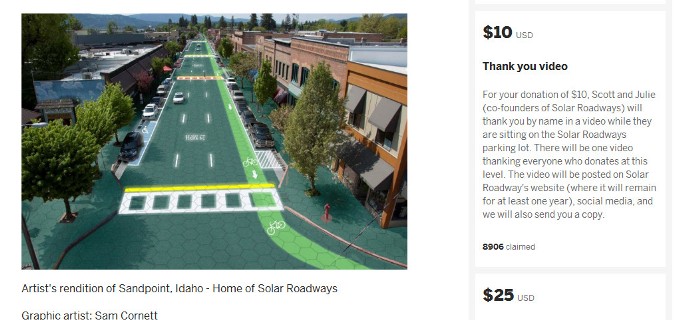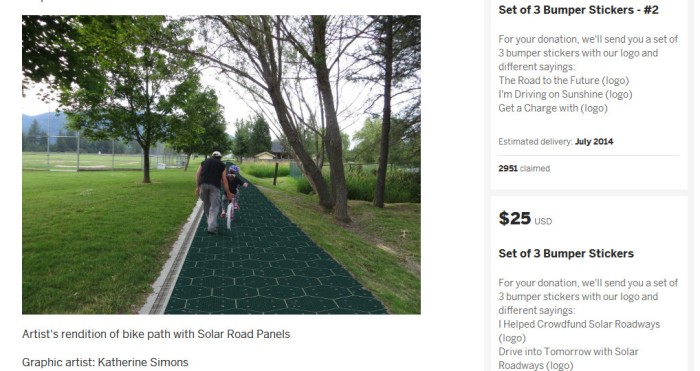Solar Roadways: A Viable Solution to Power and Greenhouse Gas Problems
The idea sounds high-tech but it isn’t. Roads and parking lots exposed to the bright rays of the sun can soon become power-generating fixtures. The initiative has become a hit on one international crowdfunding site. It is now considered as Indiegogo’s most popular campaign ever. The crowdfunding campaign is called Solar Roadways and it aims to convert roads and parking lots into gigantic solar panels that can produce power, reduce greenhouse gases by up to 75%, and melt snow.
What Is Solar Roadways?
Solar Roadways is a modular paving system that covers the surfaces of roads and parking lots with highly durable solar panels capable of taking the weight of trucks that are as heavy as 250,000 lbs. As shown in the projections at the official Solar Roadways website, a nationwide implementation of Solar Roadways is expected to be capable of providing for all the electricity needs of homes and businesses.
As of the latest Indiegogo update, the crowdfunding campaign has already overshot its target by 93%. It has now accumulated a total of $1,934,648 or $934,648 higher than the $1,000,000 target. The campaign started in April 21 and will close on the 20th of June this year.
Features and Advantages of Solar Roadways
In addition to power generation, Solar Roadways also offer a host of other advantages. These include the mechanisms for melting frozen water to avoid snowy or icy roads, imperviousness to potholes, smart traffic monitoring, embedded LED lights to facilitate safe driving at night, and the ability to warn drivers about dangers ahead of them. Solar Roadways are also designed to provide space for the safe and secure installation of power and data cables. Additionally, it has sections that can facilitate the treatment, storage, and transport of stormwater. The panels can also serve as means for improving mobile communications by getting rid of “dead spots.” Moreover, Solar Roadways have been designed to support the safe and reliable deployment of autonomous vehicles.
The glass that will be used on the solar panels has been tested for traction, load capacity, and impact resistance. It was found that it is durable enough. Additionally, the slipperiness of the glass has been addressed by coming up with texture patterns that is so grippy it tore the rubber boot off the pendulum device used to test road friction.
Costs and Output
Cost computations are still being undertaken. The people responsible for the project are still in the process of completing the installation of a prototype parking lot. Prototyping costs are expected to be presented in July this year, along with the final report for the project’s contract. Data from different seasons when the panels are operating have to be compiled since the panels will expectedly have different levels of performance with varying amounts of sunlight hitting the panels throughout the different seasons.
Nevertheless, it is possible to do approximations particularly in the case of the United States. According to Solar Roadways estimates, there could be around 31,250.86 square miles of roads, parking lots, playgrounds, bike was, driveways, sidewalks, and other similar impervious surfaces that can be replaced with Solar Roadways tech. If these surfaces get replaced with solar panels with 18.5% efficiency and exposed to full daylight at 4 hours per day, it is possible to produce 21.827 trillion kilowatt hours of electricity. That’s more than what the United States currently needs.
Solar Roadways did actual tests in Northern Idaho from January to February with worst case scenarios taken into account. It was found that there is no need to take the effort of tilting the panels towards the sun since the horizontal panels in the test actually produced more power compared to those that have been tilted. Also, it was found that vehicle headlights can likewise be processed by the panels to generate electricity.
Reducing Greenhouse Gas Emissions
It is estimated that the deployment of Solar Roadways can cut greenhouse gas emissions by around 50%. With optimistic estimates, it is believed that the full deployment of Solar Roadways can reduce the greenhouse gases produced in the United States by up to half.
Hopefully, Solar Roadways can be implemented in full scale soon. It is an interesting idea that is viable enough as tested. The only hurdle is perhaps the funding and the openness of governments to do even just one full scale test implementation in a town or city. Together with carbon capture technology, it should be able to provide highly evident benefits in the fight against global warming and climate change.


